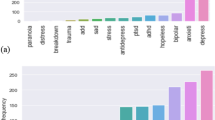Abstract
The blue feeling is the sensation which affects people when they feel down, depressed, sad and more generally when they are in a bad feeling state. In some cases, it is a recurring situation in their everyday life and it can be the first symptom of more complex psychological diseases such as depression. In the last decade, as consequence of the quick increase of detected cases of depression in children and teenagers, it has become very important to find strategies for a timely detection of this pathology. In this work, we describe a model that can support the detection task, by identifying some warning scenarios of blue feeling. The proposed architecture is composed by modules focused on different aspects that characterize the scenario: changes in heart rate, reduction of sleep, reduction of activities performed, increases of use of negative phrases and words. In particular, in this paper, we describe the approach adopted to analyze users posts on social media networks (SMNs) by using natural language processing techniques. The proposed approach is evaluated through an experimental session over a dataset of Facebook posts. The results show good performance in the detection of negative feeling.
Access this chapter
Tax calculation will be finalised at checkout
Purchases are for personal use only
Similar content being viewed by others
Notes
- 1.
- 2.
- 3.
- 4.
- 5.
- 6.
References
Alm, C.O., Roth, D., Sproat, R.: Emotions from text: machine learning for text-based emotion prediction. In: Proceedings of Conference on Human Language Technology and Empirical Methods in Natural Language Processing, pp. 579–586. Association for Computational Linguistics (2005)
Binali, H., Wu, C., Potdar, V.: Computational approaches for emotion detection in text. In: 2010 4th IEEE International Conference on Digital Ecosystems and Technologies (DEST), pp. 172–177. IEEE (2010)
Carney, R.M., Freedland, K.E.: Depression and heart rate variability in patients with coronary heart disease. Clevel. Clin. J. Med. 76(Suppl 2), S13 (2009)
Danisman, T., Alpkocak, A.: Feeler: Emotion classification of text using vector space model. In: AISB 2008 Convention Communication, Interaction and Social Intelligence, vol. 1, p. 53 (2008)
Dresner, E., Herring, S.C.: Functions of the nonverbal in CMC: emoticons and illocutionary force. Commun. theory 20(3), 249–268 (2010)
Ekman, P., Oster, H.: Facial expressions of emotion. Annu. Rev. Psychol. 30(1), 527–554 (1979)
Franzen, P.L., Buysse, D.J.: Sleep disturbances and depression: risk relationships for subsequent depression and therapeutic implications. Dialogues Clin. Neurosci. 10(4), 473 (2008)
Goldberg, L.R., Johnson, J.A., Eber, H.W., Hogan, R., Ashton, M.C., Cloninger, C.R., Gough, H.G.: The international personality item pool and the future of public-domain personality measures. J. Res. Pers. 40(1), 84–96 (2006)
Goldberg, Y.: A primer on neural network models for natural language processing. CoRR abs/1510.00726 (2015). http://arxiv.org/abs/1510.00726
Haley, W.E., Turner, J.A., Romano, J.M.: Depression in chronic pain patients: relation to pain, activity, and sex differences. Pain 23(4), 337–343 (1985)
Hancock, J.T., Landrigan, C., Silver, C.: Expressing emotion in text-based communication. In: Proceedings of SIGCHI Conference on Human Factors in Computing Systems, pp. 929–932. ACM (2007)
Harris, Z.: Distributional structure. Word 10(23), 146–162 (1954)
Kalman, Y.M., Gergle, D.: Letter repetitions in computer-mediated communication: a unique link between spoken and online language. Comput. Hum. Behav. 34, 187–193 (2014)
Kosinski, M., Matz, S.C., Gosling, S.D., Popov, V., Stillwell, D.: Facebook as a research tool for the social sciences: opportunities, challenges, ethical considerations, and practical guidelines. Am. Psychol. 70(6), 543 (2015)
Lipkus, A.H.: A proof of the triangle inequality for the tanimoto distance. J. Math. Chem. 26(1), 263–265 (1999)
Ma, C., Prendinger, H., Ishizuka, M.: Emotion estimation and reasoning based on affective textual interaction. Affect. Comput. Intell. Interact. 622–628 (2005)
Mikolov, T., Chen, K., Corrado, G., Dean, J.: Efficient estimation of word representations in vector space. arXiv preprint arXiv:1301.3781 (2013)
Millon, T., Davis, R.O.: Disorders of Personality: DSM-IV and Beyond. Wiley, New York (1996)
Mohammad, S.M., Turney, P.D.: Emotions evoked by common words and phrases: using mechanical turk to create an emotion lexicon. In: Proceedings of NAACL HLT 2010 Workshop on Computational Approaches to Analysis and Generation of Emotion in Text, pp. 26–34. Association for Computational Linguistics (2010)
Moreno, M.A., Jelenchick, L.A., Egan, K.G., Cox, E., Young, H., Gannon, K.E., Becker, T.: Feeling bad on facebook: depression disclosures by college students on a social networking site. Depress. Anxiety 28(6), 447–455 (2011)
Polignano, M., Basile, P., Rossiello, G., de Gemmis, M., Semeraro, G.: Learning inclination to empathy from social media footprints. In: Proceedings of 25th Conference on User Modeling, Adaptation and Personalization, pp. 383–384. ACM (2017)
Rude, S., Gortner, E.M., Pennebaker, J.: Language use of depressed and depression-vulnerable college students. Cogn. Emot. 18(8), 1121–1133 (2004)
Sheps, D.S., Rozanski, A.: From feeling blue to clinical depression: exploring the pathogenicity of depressive symptoms and their management in cardiac practice (2005)
Strapparava, C., Mihalcea, R.: Semeval-2007 task 14: affective text. In: Proceedings of 4th International Workshop on Semantic Evaluations, pp. 70–74. Association for Computational Linguistics (2007)
Strapparava, C., Valitutti, A., et al.: Wordnet affect: an affective extension of WordNet. LREC. 4, 1083–1086 (2004)
Suttles, J., Ide, N.: Distant supervision for emotion classification with discrete binary values. In: Gelbukh, A. (ed.) CICLing 2013. LNCS, vol. 7817, pp. 121–136. Springer, Heidelberg (2013). https://doi.org/10.1007/978-3-642-37256-8_11
Thase, M.E.: Depression, sleep, and antidepressants. J. Clin. Psychiatr. 59, 55–65 (1997)
Acknowledgment
This research has been supported by “Microsoft Azure for Research program 2016–2017”, which provides the access to all the Azure technologies for computing the data described in this work.
Author information
Authors and Affiliations
Corresponding author
Editor information
Editors and Affiliations
Rights and permissions
Copyright information
© 2017 Springer International Publishing AG
About this paper
Cite this paper
Polignano, M., de Gemmis, M., Narducci, F., Semeraro, G. (2017). Do You Feel Blue? Detection of Negative Feeling from Social Media. In: Esposito, F., Basili, R., Ferilli, S., Lisi, F. (eds) AI*IA 2017 Advances in Artificial Intelligence. AI*IA 2017. Lecture Notes in Computer Science(), vol 10640. Springer, Cham. https://doi.org/10.1007/978-3-319-70169-1_24
Download citation
DOI: https://doi.org/10.1007/978-3-319-70169-1_24
Published:
Publisher Name: Springer, Cham
Print ISBN: 978-3-319-70168-4
Online ISBN: 978-3-319-70169-1
eBook Packages: Computer ScienceComputer Science (R0)




